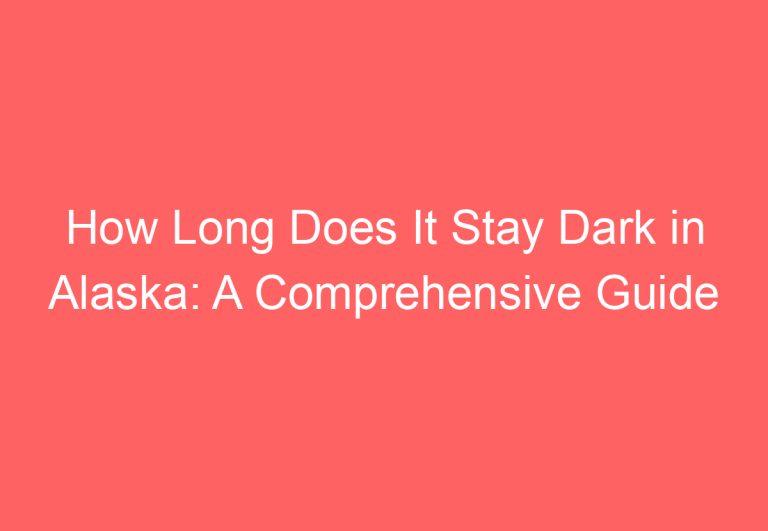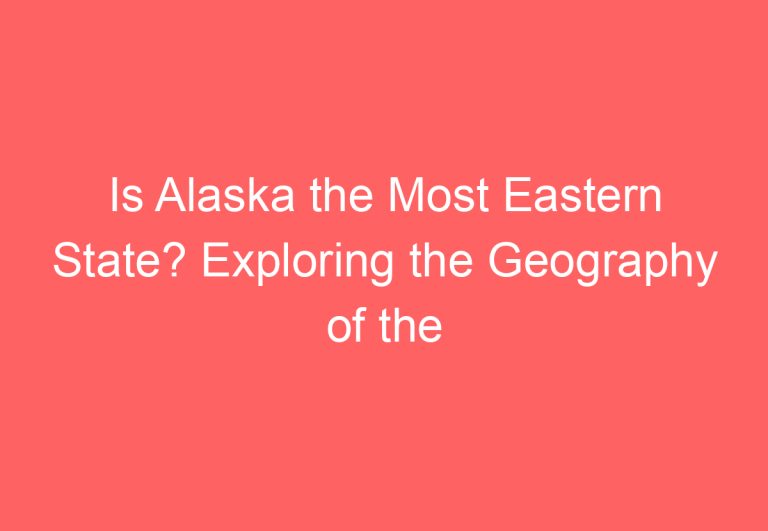How Much of Alaska is Habitable: Exploring the State’s Livable Areas
Alaska is known for its vast wilderness and rugged terrain, making it a popular destination for outdoor enthusiasts. However, how much of Alaska is actually habitable? The answer to this question is not straightforward, as it depends on various factors.

One important factor is the state’s population density, which is the lowest in the United States. With a population of approximately 731,000 people, much of Alaska’s land remains uninhabited and untouched by human activity. In fact, according to a TravelAsker article, a significant percentage of Alaska’s land is designated as federal land, which means it is preserved for conservation, recreation, and other public uses.
Despite the large amount of uninhabited land in Alaska, there are still areas where people live and work. The state’s largest city, Anchorage, has a population of over 290,000 people and is home to many businesses and industries. Other cities and towns, such as Juneau and Fairbanks, also have significant populations. However, even in these areas, the rugged terrain and harsh climate can pose challenges for those who call Alaska home.
Geography and Climate

Land Area and Geography
Alaska is the largest state in the United States, with a land area of more than 570,000 square miles. It is larger than Texas, California, and Montana combined. The state is home to a diverse range of geographic features, including forests, tundra, lakes, islands, and glaciers.
The state’s geography is largely dominated by its mountain ranges, including the Alaska Range, the Brooks Range, and the Chugach Mountains. The state also has more than 3.5 million lakes of 20 acres or larger, and marshlands and wetland permafrost cover over 188,000 square miles of land.
Climate and Temperature
Alaska has a subarctic and arctic climate, with long, cold winters and short, cool summers. The state’s climate is heavily influenced by its high latitude and proximity to the Arctic Ocean.
As a region, Alaska has warmed more than twice as rapidly as the rest of the United States over the past 60 years, with average annual air temperature increasing by 3 °F and average winter temperature increasing by 6 °F. The summers can have temperatures reaching into the 90s °F, while in the winter, the temperature can fall below −50 °F, and in rare cases, below −60 °F. Precipitation is generally sparse around the year, peaking during the summer months, and virtually all precipitation between October and April falls as snow.
Wilderness and National Parks
Alaska is home to some of the most pristine wilderness areas in the world, including 16 national parks and preserves, such as Denali National Park and Preserve, Glacier Bay National Park and Preserve, and Kenai Fjords National Park. These parks protect a wide range of natural features, including glaciers, forests, lakes, and wildlife.
The Arctic National Wildlife Refuge is one of the most remote and untouched wilderness areas in the world, covering over 19 million acres of pristine arctic tundra. The refuge is home to a wide range of wildlife, including polar bears, caribou, and muskoxen.
Alaska’s wilderness areas and national parks provide visitors with a unique opportunity to experience the state’s natural beauty and wildlife. However, visitors should be aware of the potential dangers posed by Alaska’s harsh weather and rugged terrain, and should take necessary precautions to ensure their safety.
Habitability and Human Presence

Alaska is the largest state in the United States, covering an area of approximately 663,300 square miles. Despite its vast size, only a small percentage of the land is habitable. In this section, we will explore the human presence in Alaska, including its population, urban areas, economic activities, and challenges.
Population and Urban Areas
As of 2024, Alaska’s population is estimated to be around 731,000 people, making it the least densely populated state in the country. The majority of the population is concentrated in urban areas such as Anchorage and Fairbanks. These cities offer basic amenities such as housing, education, health, and transportation, making them the primary centers of economic and social activities.
Economic Activities and Resources
Alaska’s economy is primarily driven by its rich natural resources such as oil, gas, minerals, and seafood. The state is also home to several indigenous species such as salmon, caribou, and moose, which support the local economy and provide food for the population. Additionally, the federal government owns approximately 24% of the land area, which is used for various economic activities such as livestock grazing, mining, and timber harvesting.
Challenges and Adaptations
Alaska’s harsh climate and rugged terrain present several challenges for its inhabitants. Climate change is a significant concern, as it is causing the melting of permafrost, rising sea levels, and extreme weather conditions. These changes are affecting the habitat of several species and making it difficult for people to adapt to the changing environment. Housing is also a significant challenge in Alaska, as many areas are uninhabited or undeveloped, making it difficult to provide basic amenities to the population.
In conclusion, Alaska’s habitable land area is relatively small compared to its total land area. While the state offers abundant natural resources and opportunities for economic growth, its harsh climate and rugged terrain present several challenges for its inhabitants. Despite these challenges, the people of Alaska continue to adapt and prepare for the future, making it a unique and fascinating place to live.
Frequently Asked Questions

What percentage of Alaska’s land is actually inhabited?
Alaska is the largest state in the United States by area, but it has a relatively small population. According to the United States Census Bureau, as of 2020, Alaska’s population was approximately 731,545. The inhabited land area of Alaska is estimated to be around 1 percent of the state’s total land area. This means that the vast majority of Alaska’s land remains untouched and uninhabited.
How does Alaska’s habitable land area compare to other large states like Texas?
When compared to other large states like Texas, Alaska’s habitable land area is relatively small. Texas has an estimated 94 percent of its land area that is considered habitable, while Alaska has only around 1 percent. This is due to Alaska’s harsh climate and rugged terrain, which make it difficult for people to live in many areas of the state.
In terms of population, how much of Alaska is densely populated?
Alaska is one of the least densely populated states in the United States. As of 2020, the population density of Alaska was approximately 1.3 people per square mile. This is significantly lower than the national average population density of 87.4 people per square mile.
Which areas of Alaska are considered uninhabitable due to ice and extreme conditions?
There are several areas of Alaska that are considered uninhabitable due to their extreme conditions. These areas include the Arctic National Wildlife Refuge, which is located in northeastern Alaska and is home to many species of wildlife, including polar bears, caribou, and wolves. Other uninhabitable areas include the Brooks Range, which is a mountain range that stretches across northern Alaska, and the Aleutian Islands, which are a chain of islands located in the southwestern part of the state.
What proportion of Alaska remains unexplored or undeveloped?
Despite being the largest state in the United States, Alaska remains largely unexplored and undeveloped. According to the National Park Service, approximately 54 percent of Alaska’s land area is designated as protected wilderness areas, national parks, and other protected areas. This means that much of Alaska’s land remains untouched and unexplored.
Why are large regions of Alaska left untouched or unexplored?
The rugged terrain and harsh climate of Alaska make it difficult for people to live in many areas of the state. Additionally, much of Alaska’s land is protected by federal and state agencies, which limits development and exploration in these areas. Finally, the cost of developing and exploring remote areas of Alaska can be prohibitively expensive, which further limits exploration and development in these areas.






